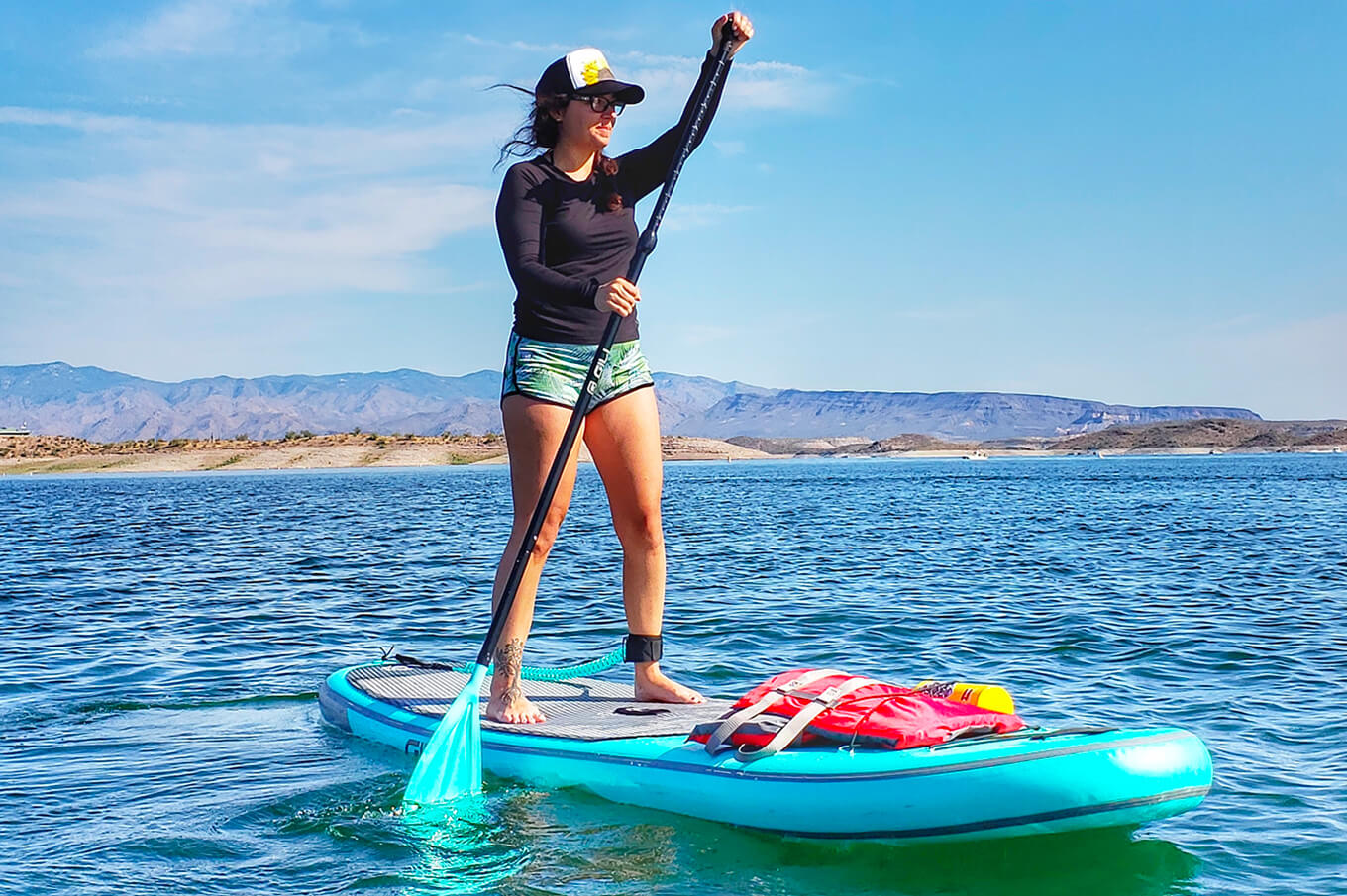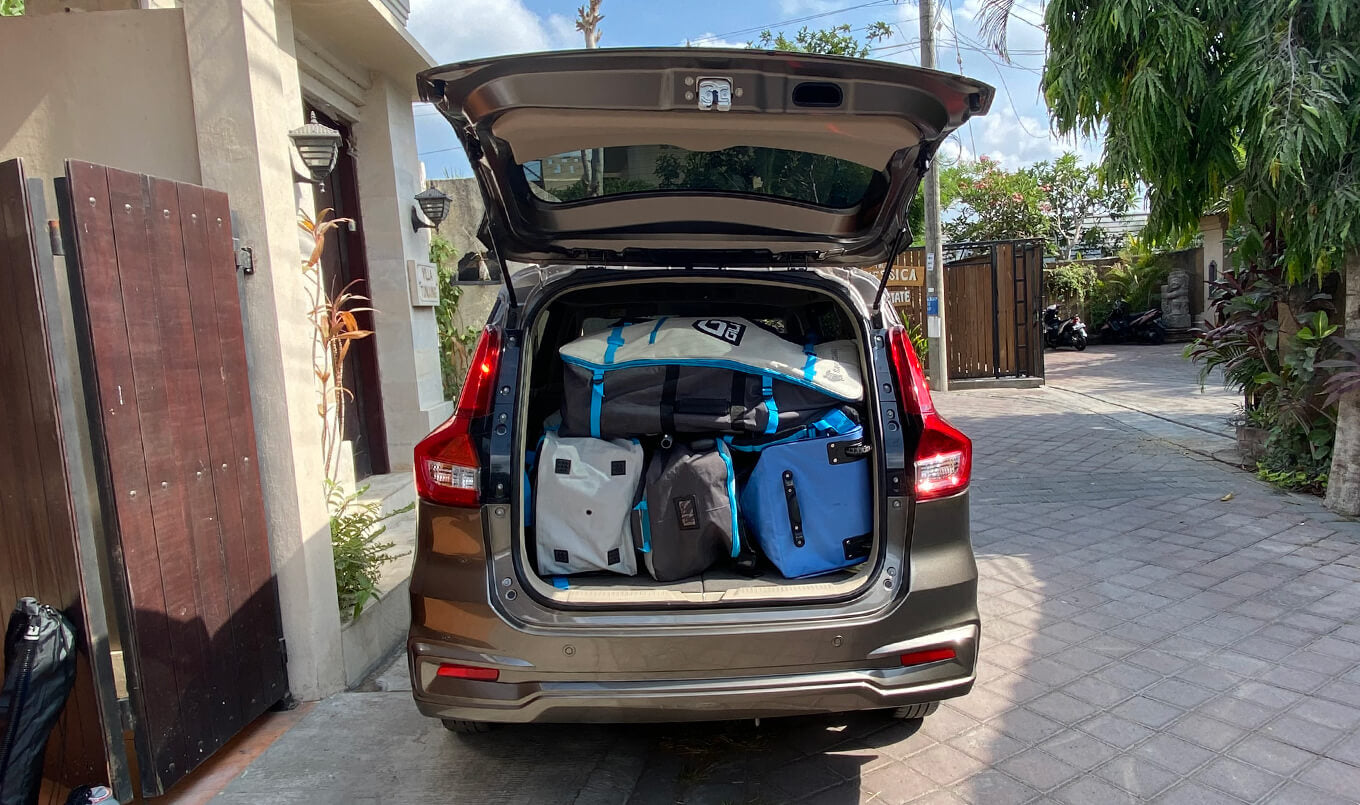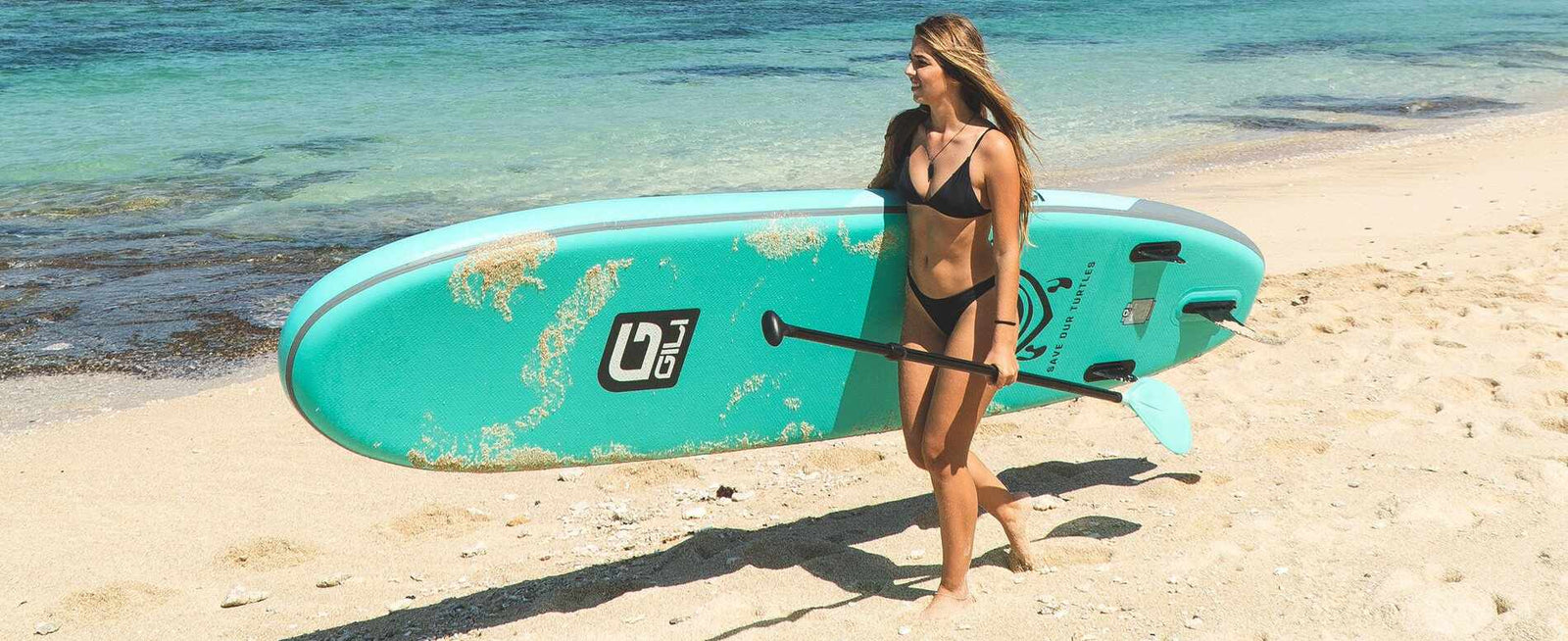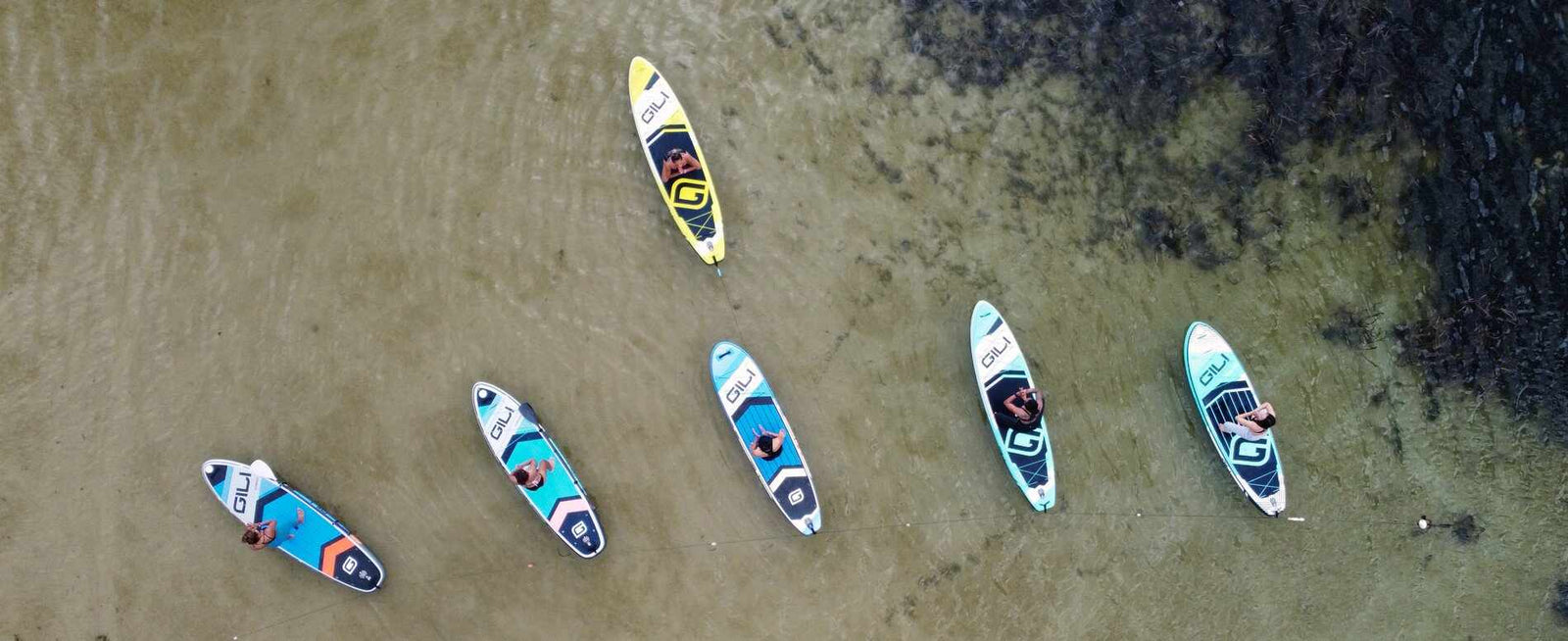Your Cart is Empty

9 Things You Need to Know Before Buying Your Next SUP
How To Buy A Paddle Board
If you’re in the market for a stand up paddle board, there’s so much to figure out before making the purchase. From choosing the right SUP size to knowing your skill level, there’s a lot to learn in order to choose paddle board that you’ll love and use for the long run.
When deciding on a paddle board, start by considering your own lifestyle, SUP goals, and budget. (And don’t be afraid to ask one of our pros if you get stumped.) Here are some important details to consider before getting started.
Topics Covered in this Article
- 1. What Will You Use Your SUP For?
- 2. What Is Your SUP Skill Level?
- 3. Will You Be Paddling With Pets And Friends?
- 4. Which Size Paddle Board Do You Need?
- 5. What Type Of Fin System Do You Need?
- 6. What Type Of Hull Is Best For You?
- 7. Where Will You Store Your SUP?
- 8. What’s Your Budget? How Much Are Paddle Boards?
- 9. Should You Get an Inflatable SUP or A Hard Paddle Board?
- 10. Why Buy Your Next Paddle Board SUP From GILI Sports?
1. What Will You Use Your SUP For?
Do you have a favorite SUP activity? There are plenty of types of paddle boards, so whatever you most like to do on the water should serve as your guide.
All Around SUPs
If you just love getting out on the water for a low-key afternoon, consider an all purpose, All Around SUP. You love to paddle for the sake of paddling, whether you bring friends out on the water with you or treat it more like a meditative, back-to-nature experience. An all around sup is great board for general recreation and experiencing all of what SUP has to offer.

Yoga SUPs
If you’re ready to take your yoga practice from the studio to the water, pay close attention to the board’s deck pad (EVA pad.) You’ll want a wide, comfortable deck pad for SUP yoga. This is super important, because you’ll want your hands and feet to feel at ease while you move between asanas. Seek out a wider board (at least 31”) so you have the space to fully lose yourself in the poses without dipping into the water. We highly recommend inflatable paddle boards for SUP Yoga as they sit higher on the water, and will keep you drier than an epoxy board.

Fishing SUPs
If you want to fish on your paddle board, you’ll need plenty of room for your fishing poles, tackle box, and other gear. Look for a board with enough weight capacity and volume for both you and your gear. Make sure the board also has enough length and width to accommodate it all. Look for a SUP with built-in Scotty mounts so you can add rod holders, fish finders, and other accessories.
Touring SUPs
Anyone who loves SUP touring should choose a board that’s longer and narrower - which excel at long distance, straight-line paddling. These boards are a great option for more serious paddlers while still being stable enough for intermediate skill levels. SUP touring boards are designed for long-distance affairs, so any board that can help you move more efficiently to conserve energy is a winner. If you’re going to spend that much time standing in one place, you’ll also want to be comfortable, so make sure the deck pad is easy on your feet.

Surf SUPs
Hit the waves with a small, zippy board that can help you carve through the water at high speeds. Surfing paddle boards are best suited for advanced paddlers. They usually measure between 9’ to 10’6” long and 29” to 32” wide. An advanced paddler can also use a surfing sup for all-around paddling.
Racing SUPs
The adrenaline rush of SUP racing calls for a nimble board that you can charge above all the rest, between about 12’ to 12’6” long and 29” to 32” wide. If you don’t need a pure race board but still like speed, look for a long, hybrid style board or touring board.
Whitewater & River SUPs
Taking to the rapids in your SUP is the wildest of adventures. If this activity calls to you, opt for a wider board for stability in fast-moving waters. A SUP with a width around 35” to 36” wide and about 9’ to 10’ long will serve you well in the river rapids.

Hybrid SUPs
Hybrid SUPs are a new exciting category, and they’re designed as multi-use boards that can be used for all kinds of SUP activities. These boards are generally wider, and they are awesome all around family boards. Hybrid SUPs are generally 10’6 to 11’6 long and 33” to 35” wide. Hybrid boards feature a more pointed nose and widened tail, finding a middle ground between stability and speed, resulting in a really versatile and fun board to paddle.

2. What is your SUP Skill Level?
Your level of experience will make a big impact on what kind of board you need, so consider this before you buy your next SUP. You might look for specialized boards for specific types of paddling, depending on your goals and capabilities.
How Experienced Are You?
What’s your skill level when it comes to boarding in wind or waves? What about balancing? If you’re more of a beginner, you’ll want to opt for a wider board, whereas more advanced paddlers might want a more specialized board for their favorite SUP activity, like SUP yoga, touring, or surfing.
Is This Your First SUP Purchase?
Your first SUP should be versatile, which makes an all around board a great option. All around boards offer a jack-of-all trades approach to a myriad of SUP activities. They measure between 10’ to 12’ long and 31” to 35” wide, and are perfect if you would like to use your board for a wide range of activities.
The Perfect Size SUP For Beginners
If you’re new to SUP, your ideal board size is between 10’6” to 11’6” long and 31” to 35” wide. Keep in mind that when choosing your board, height and weight matters - and not just your own. If you want to paddle with any extra baggage, whether that be your best friend, your pet, or your tackle box, you’ll need to make sure your board is able to accommodate more than just your own weight.

3. Will You Be Paddling With Pets And Friends?
They say in life that you’ll never walk alone - well, you’ll never paddle alone either. Especially when you bring human and animal friends onboard with you!
Paddling With Pets
Your four-legged best friends will love SUP just as much as you do! It’s important to take some safety concerns into consideration - you’ll want to consider putting your dog in a flotation device with a handle on top. Don’t put your dog on a leash when you’re on the SUP - it could pose a choking hazard if your pup ends up in the water.
Before you ask, yes: some people do take their cats on their paddleboards. Most cats hate water, right? If your kitty is keen and especially chill - or brave - strap her into a cat-sized flotation device and head out onto the water!
For all we know, there’s someone out there who’s taken their hamster or their goldfish with them too...not that we’d recommend that!. Will you be the first to send us a snapshot of your lizard, parrot, or other amazing animal on a SUP? We’ve love to feature you on our website!

Paddling With Kids
Paddling is a fantastic way to bond with the kids in your life while introducing them to a new outdoor sport. It’s like scout camp, except, you know, way cooler. Who needs iPads and video games when you’ve got your paddle board and nature? Make sure your kids wear a PFD while onboard.

Paddling With Your Friends And Family
When you’re paddling with a friend on board, there’s never a dull moment. You can bring a friend, your mom, or even a date out on the water. Trust me, you’ll definitely get points for creativity!
Paddling With Gear: Bungees
In addition to your pals or pets, you’ll likely want to carry some gear with you. For that, you’ll need bungees, which will help secure your dry bag and other gear to the board. How many bungees you need will depend on how much gear you plan to carry with you. For lots of gear, you’ll want both front and rear bungees. If you won’t have too much gear, one bungee system will do the trick. When choosing a board, ask yourself, how much gear do you need to bring on your SUP?

What Size SUP Do I need if I’m bringing an Extra Person?
Paddling with your buddies on board means you’ll need a paddle board that has the weight capacity to fit both of you. Make sure the board’s weight capacity exceeds the combined weight of you, your friend, and your gear. When you calculate that figure, add an extra 10-15 lbs to the number just in case. Otherwise, the board will drag in the water and will be difficult to paddle.
4. What Size Paddle Board Do You Need?
Paddle boards in a variety of shapes and sizes. Read on to find the perfect SUP size for you.
Weight Capacity
When choosing your SUP, one factor you’ll really need to be aware of is weight capacity, which is determined by a board’s volume, shape, and dimensions. Weight capacity is how much weight the total weight the board can comfortably support. When calculating weight, include the weight of you and boarding companions, and any gear you’ll bring with you.
Width
The wider the board, the easier it is to balance and to maneuver. Narrower boards are great for skill-based paddling like SUP surfing and racing, but you’ll want to avoid boards narrower than 30” when you’re first starting out. Wider paddle boards make awesome all around, do-everything boards, and are great for SUP yoga and fishing.
Length
Longer boards are better for SUP touring, and long-distance paddling, whereas shorter boards are best for speedy activities like surfing. When thinking about length, also think about how far you’ll be carrying your board. Longer boards can be a pain in the neck (literally and figuratively) to carry too far, especially in windy weather.
Thickness
If you’re opting for an inflatable board, look for a width of 6” or more. Inflatable boards that are less than 6” are less rigid, and they can start bowing in the middle on the water - definitely not a good time. Hard boards are available in a variety of different widths, based on the type of SUP activity.
Quick Size Reference Guide
Quick suggestions to get you started:
Paddle Boards Under 10’
- Ideal for SUP Surfing
- A good option for intermediate or advanced paddlers who can sacrifice board stability for more maneuverability
- Can also be a good option for young kids
Paddle Boards over 10’ to 11’6
- Excellent for all-around board use
- The most common SUP Size
- Come in widths from 31” to 35”
- Great if you’re into general recreation paddling, SUP yoga, Touring, & SUP fishing
Paddle Boards Of 12’ Or More
- Good for intermediate and advanced paddlers
- Often used for racing or long-distance sup touring
- Boards narrower than 31” are designed for racing
- 12’ Boards with widths of 32” are better suited SUP Fishing and distance paddling
SUP Sizing by Activity
What’s your favorite SUP hobby? Consider these sizing tips by activity to narrow your SUP search.
- All Around Paddling: between 10’6” to 11’6” long and 31” to 35” wide. Great for both beginners and intermediates.
- SUP Fishing: Choose a SUP that’s between 10’6” to 12’ long and 32” to 36” wide. Look for a board with extra bungees, d-rings, and Scotty mounts for maximum versatility.
- SUP Yoga: Choose a board from 10’ to 11’6” long and 31” to 36” wide. You’ll want a board with an ample, comfortable deck pad for practicing those yoga poses.
- SUP Touring: aim for a touring paddle board with a displacement hull, and a size that’s between 11’ to 12’6” long and a width of 30” to 33”.
- River & Whitewater Paddling: for this, you’ll want a short inflatable SUP. Look for a board that’s between 6’ and 8’ long, with a width of 30” and 35.”
- SUP Surfing: shred your local break with a surf-friendly paddle board between 9’ and 10’6” long and 29” to 32” wide. Narrow boards like these are easier to maneuver on choppy waves, but are less stable for beginners.
- Hybrid SUPs: If you're looking for a wider, stable hybrid SUP without sacrificing too much speed. Look for a Hybrid SUP between 10'6 to 11'6 long and 33" to 35" wide.
Check out our SUP Size and Weight Chart to find the perfect size SUP for you.
5. What Type Of Fin System Do You Need?
All paddle boards need at least one main fin in order to track well in a straight line. Don't forget your fin at home - you won't be going far very quickly without a fin! Here are a few quick tips to get you started on the different types of fin systems available on modern-day SUPs.
Fin Boxes
All paddle boards will come with at least one main fin, using a Standard Fin Box (also known as a US Fin Box) or a Snap-In Fin System (common on inflatables). iSUPs can also have a US Fin box as well.
Either fin system can work well for you, however, US Fin boxes are more versatile.
Fin Setups
The most common fin setups found on paddle boards are Single Fin or 2+1 Fin setups. Occasionally, you'll see a Surf SUP with a Quad Fin, or Thruster, fin setup.
Generally, a 2+1 fin setup is ideal for most paddlers. We find single fin boards a bit lacking and less maneuverable, and quad fins are generally only needed for Surfing SUPs.

Some iSUPs feature side bites, or small, non-removable side fins. Other inflatables will feature removable side fins for better tracking and easier storage.
What's right for you will come down to personal preference and budget. For more information on fin types and fin boxes, check out our in-depth How to Choose a Paddle Board guide.
6. What Type Of Hull Is Best For You?
Paddle boards come in two different hull types: displacement hulls and planing hulls. For a deep dive into the details of hull types, check out Paddle Board Hull Types.
7. Where Will You Store Your SUP?
Reminder: SUPs need somewhere to live when you’re not on the water! Before deciding whether what size board you and - and whether you want a hard SUP or an iSUP - take a good hard look at your home’s storage options.
Longer Boards Are Harder To Store
If you’re planning to get a longer board for long-distance SUP touring, remember that it’s going to be tougher to store. If you need to drive with your board, does your car have a compatible roof rack? Do you have room for a longer board in your garage or basement?
Storing Inflatable Boards vs. Hard Boards
Inflatable boards are very simple to store - once you deflate them, you can simply pack them up in a SUP backpack and store them wherever in the house you’d like. Around 36” tall by 14” wide, iSUP bags can fit almost anywhere.
Hard SUPs, on the other hand, require a TON more storage space. You can keep your hard SUP safe on a storage rack in your home or garage. Other people opt to hang their hard boards on the wall or ceiling in a setup that doubles as storage and decoration. If you’re in a pinch without a rack, you can of course also just store a hard board without a rack in the house. Just make sure the board’s weight is evenly distributed to prevent any damage, and never store your board (inflatable or hard board) outside for long periods of time.
How To Transport Inflatable vs. Hard Boards
Just like inflatable boards are easier to store, they’re also easier to transport. All you need to do is pack them up in their bag to go and throw them in the trunk of your car. You’ll need to transport hard boards on the roof of your car (with a proper rack) to get them from home to the water. It’s not a super difficult process, but it’s definitely a bit more involved than transporting your iSUP.

8. What’s Your Budget?
It would be cool if we lived in a vacuum where cash didn’t count, but like with all things, shopping for SUPs is an area where budget makes an impact.
How Much Are Paddle Boards?
The average SUP can cost anywhere from $400 to $1100. Generally, the larger the board is, the more it will cost. Another factor in pricing is the materials that go into the board (for this reason, hard SUPs pricier than iSUPs.) Good quality inflatable SUPs go for $400 to over $800 - but you get what you pay for!
If you’re a beginner, look for an all-around board that is versatile great for most recreational activities. Highly specialized boards for advanced paddling are typically more expensive. All in all, when it comes to paddle boarding, you get what you pay for - you’ll want to look for a board that does not compromise quality.
Cheaper, more basic level SUPs can run under $400. Premium priced boards can offer more options and versatility and can range from around $450 to $1000. Choosing a higher quality board is going to provide a lot more value for your money.
At GILI, we offer high quality, entry-level paddle boards all the way to high performance, high-end SUPs with premium features.
Shop our Paddle Board Collection
If you need a high quality SUP on a budget, look at our used paddle boards for sale.
9. Should You Get an Inflatable SUP or A Hard Paddle Board?
Inflatable SUPs are new and not as well known as hard boards. So which one is right for you? One of the biggest questions we get asked is "Are inflatable SUPs any good?"

Are Inflatable SUPs any good?
Short answer - Yes, they are! Both inflatables and epoxy SUPs are great for different activities, so there’s really no “wrong” decision here. Pressure’s off! It just depends on what you need.
Inflatable SUPs 101
Inflatable SUPs offer a whole lot of convenience. They’re easier to store and transport, and are lighter to lift. They’re great for most types of SUP hobbies, so if you’re interested in general SUP, an inflatable board is an excellent option for you. You’ll especially want to opt for an inflatable SUP if you’re into SUP yoga, because they float higher above the water than hard SUPs - keeping you high and dry above the water.
Hard SUPs 101
Hard SUPs are usually made of an EPS foam core wrapped in some combination of fiberglass, wood, carbon fiber, epoxy, or plastic. Hard SUPs can be harder to store and transport, and tougher to balance on if you’re new to paddling. That said, if a diehard SUP surfer or SUP racer, a hard board is the way to go.
If you’re seeking the maximum performance from a paddleboard and you have the storage space - an epoxy/hard SUP is for you.
We Recommend Inflatable Paddle Boards for Most People
Each type of SUP has its place, but for most paddlers, an iSUP is your best option. Inflatable paddle boards are more durable, convenient, and easy to use.

10. Why Buy Your Next Paddle Board From GILI Sports?
GILI Sports has all the quality and expertise you need to help you choose the perfect SUP.
Quality Comes First
At GILI Sports, we’ll stop at nothing to ensure you have the highest quality paddle boards at the best prices. We professionally design and personally test every single product we sell.
Direct to Consumer
By manufacturing and selling our boards direct to you, we cut out the middleman and sell our products at affordable prices.
60 Day Love it Guarantee
We settle for nothing less than 100% customer satisfaction. Try out your board - if you don’t love it, send it back to us within 60 days for a hassle-free refund.
Every GILI Purchase Helps Save Our Oceans
For every paddle board we sell, we donate to charities that support our oceans, reefs, and endangered sea life. Every board we sell has a special logo on it - this tells you where your money is going. Love sea turtles? Buy our Save Our Turtles board. Want to help save our oceans and reefs? You can help us do that too.
We also donate to a range of other charities, such as ocean plastic removal charities, whale foundations, and more - signified by our Save Our Oceans boards.
Customers Come First
Customer happiness is our number one priority. We’re here to help you by phone, email, and chat. Check out hundreds of reviews on our website and around the web - without you, we wouldn’t be here today!
2 Year Warranty
We offer a 2-year warranty on all of our SUP packages. We’re confident in our products. If you have an issue with one of your boards, we’ll fix you right up.
We Love SUP AS Much As You Do
We love seeing happy customers on our boards. We want everyone to be able to enjoy the calming, joyful experience of paddle boarding, and that’s what drives us every day.
Have more specific questions? Contact the experts at GILI Sports or ask us in the comments below!
Leave a comment
Comments will be approved before showing up.


